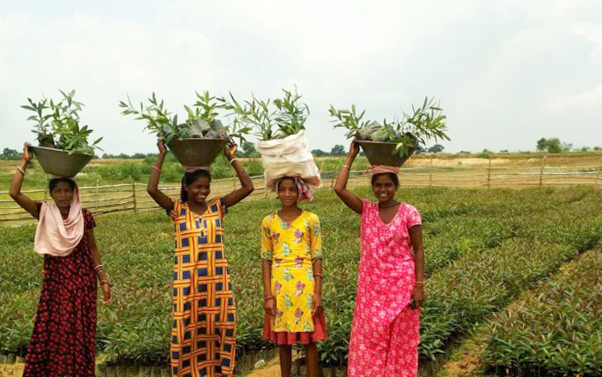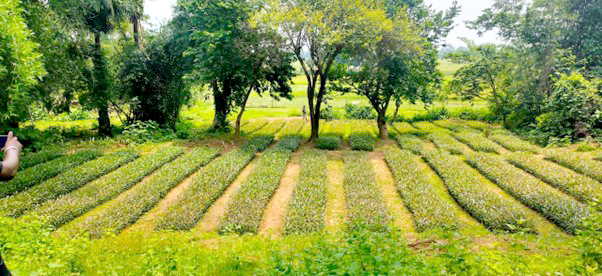|
Tasar Sericulture as Avenue of
Sustainable Livelihood

Women farmers working at the community nursery
A
Tasar plantation project in Jangal Mahal of Jhargram in West Bengal was sanctioned under the Scheme of Fund for Regeneration of Traditional Industries (SFURTI) of the Ministry of Micro, Small and Medium Enterprises (MoMSME) with the Indian Micro Enterprises Development Foundation (IMEDF) on February 11, 2022. Professional Assistance for Development Action (PRADAN) in collaboration with the Tasar Development Foundation (TDF) has systematically developed the methodologies of Tasar plantation in privately owned wastelands. The entire effort significantly draws on the initiatives of local communities, and builds their capacities and ownership to promote sustainable livelihoods based on Tasar sericulture.
Mobilisation
The project, supported by Livelihood Funds, was launched in 2021 after the COVID-19-led lockdown was lifted. The project picked momentum during the second wave of the pandemic, when the team mobilised more than 1,500 hectares of land. The second-year seedling requirement for 1,500 ha was 2 million including the 10% gap-filling requirement. Additional 10% seedlings were also raised as reserves to handle any shortfall or any unforeseen circumstances.
The Asan seed (Terminalia tomentosa) is very delicate. If it rains continuously for a week, it damages the seed on the germination bed. However, the deficit in the number of Asan seedling was compensated with the Arjuna (Terminalia arjuna) seedlings. This year they raised approximately 20,000 shisham (Dalbergia sissoo) seedlings for the boundaries. Due to the late collection of Asan seeds, the nurseries faced germination issues of this tree species (roughly 55% of the species in the mix of three species for plantations). However, these shortfalls are being compensated with Arjuna seedlings. The verification of land records and the formation of a Tasar Vikas Samiti was challenging amid the pandemic. Plantation was completed on 2,100 hectares of land in 103 villages.
Impact
The project mobilised 1,561 ha of private fallow lands in 79 villages. As many as 1,837 joint families (as the land titles are usually owned jointly) have benefitted from it. About 4.77% of these families belong to the Scheduled Tribe and Scheduled Caste communities. It is also a 100% tribal women-led cluster.
Some 75% of the seedlings have been utilised for raising plantation and filling the gap of last year's plantation. The project team mobilised people of four villages – in a contiguous forest corridor – in the Nayagram district of West Bengal to maximise the impact towards forest protection.
Livelihood
Tasar silk is extracted from the cocoons made by the silkworm insect Antheraea. India is the largest consumer of silk and the second largest producer of Tasar silk in the world, after China (International Sericulture Commission, n.d.). Taking into consideration the domestic demand and the volume of export, the total requirement of Tasar silk is estimated to be 3,000 metric tonnes (Central Silk Board, 2017). But the country produces only about 1,000 MT of Tasar silk. The overall demand for Tasar silk thus far exceeds its supply from within India. The large gap between the demand and the supply is today filled by importing nearly 2,000 MT of silk yarn from China (Ministry of Textiles, 2013). In terms of value, the sector has a total business turnover of Rs 2,700 crore annually.
Today, Tasar receives significant patronage from a large number of youths. The market demand for Tasar has been increasing in India at an annual compounded rate of over 9% (Ministry of Textiles, 2013). In recent times, the export market too has shown considerable enthusiasm to tropical Tasar silk with countries such as the US, Germany, the UK, France, Japan, the UAE, and Qatar among the major buyers.

Arjuna trees planted at the nursery
Intervention
PRADAN has been involved in Tasar sericulture for over three decades with the objective of creating sustainable livelihoods for marginalised communities. The initiative started in the Godda district of Jharkhand and expanded to other parts of the state and the adjoining districts of Bihar, Chhattisgarh, West Bengal, and Odisha. Through this period, PRADAN has systematically worked through the entire value chain, raising host tree plantations, strengthening the seed sector, and promoting improved practices around improved silkworm rearing and yarn production and processing of the same into fabric.
Carbon footprint
Livelihoods Funds (http://www.livelihoods.eu), a Paris-based social business, has agreed in principle to provide funds for raising 3,000 ha of Tasar host plantations in the highland districts of Jharkhand and West Bengal. The fund will come from its specialised window of investment called Livelihood Carbon Fund (LCF), managed by Livelihoods Funds and supported by private companies that are committed to generating development impact while offsetting their carbon footprint or transforming their supply chains.
Key results
In terms of short-term outputs:
- 3,000 ha of Tasar host tree plantations raised in wastelands owned by 4,500–5,000 households belonging to marginalised communities.
- Each of these households will gain sustainable livelihood from Tasar silkworm rearing and cocoon production.
- The average annual earnings from Tasar silkworm rearing would be in the range of Rs 30,000–50,000 per household, which would be an over 50% increase from the current baseline income.
- Silkworm rearing in 3,000 ha results in the production of 50 million pieces of Tasar cocoons annually. At the current price of Rs 3.25 per cocoon, the gross revenue generation from cocoons would be around Rs 160 million, a major part of which will contribute to the earning of the producers.
In terms of outcomes:
- 3,000 ha of Tasar host tree plantations will sequester 1.80 million MT of carbon over a period of 15–20 years.
- Stabilisation of upland areas will retain soil (from erosion) and recharge ground water that will positively impact farming in at least 6,000 ha (that is, twice the area under plantations) of medium and low lands.
- The success of the initiative will open up major frontiers of investment opportunities, which have been unknown to the sector so far, especially for plantation raising and natural resource management.
Opportunities beyond silkworm rearing and way forward
PRADAN has long-standing work in Tasar sericulture. It has a vision of big picture. It envisages the setting up of a large production base of 3,000 ha of plantation, which would trigger the creation of livelihoods through a number of downstream activities. To illustrate this point, let us see the possibilities in post-cocoon activities:
- 45 million pieces of cocoons is equivalent to 50 MT of raw silk. At the current national production of 1,000 MT of raw silk, the produce from this project itself will add 5% to the national production, which is very significant.
- 1,500 yarn spinners will be required to work round the year to convert 50 MT of raw silk into 50 MT of silk yarn (Rs 225 million in value terms). This will result in sustainable livelihoods for 1,500 women.
- 50 MT of silk yarn is converted to 600,000 metres of silk fabric (Rs 300 million in value terms). This will generate gainful employment of 750 handloom weavers.
Apart from the above numbers, there will be an additional requirement to involve 1,000 people in various associated activities such as dyeing, calendaring, clipping, mending, packaging, and transporting.
References
Central Silk Board. 2017. Annual Report 2016-17. Bengaluru: Central Silk Board, Ministry of Textiles, Government of India
International Sericulture Commission. n.d. Statistics. Details available at https://inserco.org/en/statistics, last accessed on 16 July, 2022
Ministry of Textiles, Government of India. 2013. Annual Report 2012-13. New Delhi: Ministry of Textiles, Government of India
Col. Raman Thapar
rthapar@devalt.org
Smriti Ahuja
smritiahuja198@gmail.com
Ashish Chakravorty
ashishchakraborty@pradan.net
Back to Contents
|

